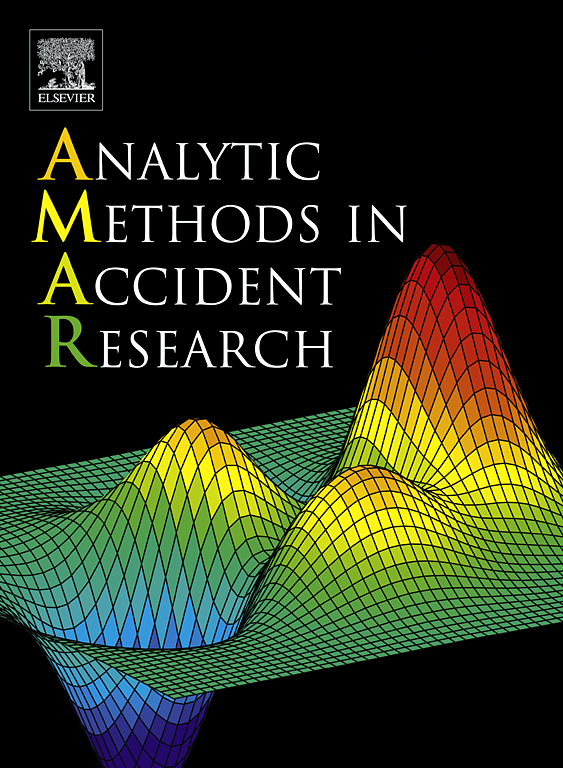具有空间效应的分组随机参数泊松-林德利模型:来自视觉环境特征和时空不稳定性的见解
IF 12.6
1区 工程技术
Q1 PUBLIC, ENVIRONMENTAL & OCCUPATIONAL HEALTH
引用次数: 0
摘要
本研究探讨了视觉环境特征对交叉口碰撞频率影响的异质性和时空变异。建立了具有空间效应的分组随机参数泊松-林德利模型,以解释宏观(县)和微观(路口)水平的空间变化。该分析利用了2020年至2022年间收集的佛罗里达州12个县的2,044个十字路口的碰撞数据,以及包括交通流量、几何设计特征和视觉环境特征在内的解释变量(从谷歌街景图像中提取)。与现有的固定参数、随机参数和分组随机参数泊松-林德利模型相比,该方法结合了宏观和微观层面的空间效应,显著提高了模型的性能。此外,通过样本外预测和边际效应分析,清楚地确定了三年期间解释变量的时间变化。植被(Vegetation)和草地(Grass)这两个视觉环境特征可以识别成组的随机参数,突出这些特征对12个县的交叉口碰撞频率的不同影响。研究结果还显示,微观层面的空间效应增强,表明在2019冠状病毒病大流行之后,相邻路口之间的空间相关性增强。影响碰撞频率的关键因素包括交通量、四足交叉路口、四车道以上的主要道路、较宽的次要道路以及驾驶员视野中车辆比例较高。这些结果为研究驾驶员视觉环境对交叉口安全的影响提供了有价值的见解,并为加强交通安全提供了政策建议。本文章由计算机程序翻译,如有差异,请以英文原文为准。
Grouped random parameters Poisson-Lindley model with spatial effects addressing crashes at intersections: Insights from visual environment features and spatiotemporal instability
This study investigates the unobserved heterogeneity and spatiotemporal variations in the effects of visual environment features on intersection crash frequency. A Grouped Random Parameters Poisson-Lindley model with Spatial Effects is developed to account for spatial variations at both the macro (county) and micro (intersection) levels. The analysis utilizes crash data from 2,044 intersections across 12 Florida counties, collected between 2020 and 2022, along with explanatory variables including traffic flow, geometric design characteristics, and visual environment features (extracted from Google Street View images). Comparing to existing methods (e.g., Fixed, Random Parameters, and Grouped Random Parameters Poisson-Lindley models), the proposed approach, which incorporates both macro- and micro-level spatial effects, demonstrates significantly improved model performance. Additionally, the temporal variations of explanatory variables over the three-year period are clearly identified through out-of-sample predictions and marginal effects analysis. Two visual environment features, Vegetation and Grass, result in the identification of grouped random parameters, highlighting the varying impact of these features on intersection crash frequency across the 12 counties. The findings also reveal a strengthening of micro-level spatial effects, indicating heightened spatial correlations between adjacent intersections following the COVID-19 pandemic. Key factors influencing crash frequency include traffic volume, four-legged intersections, major roads with more than four lanes, wider minor roads, and a higher proportion of vehicles in the drivers’ field of vision. These results provide valuable insights into the influence of drivers’ visual environment on intersection safety and offer policy recommendations for enhancing traffic safety.
求助全文
通过发布文献求助,成功后即可免费获取论文全文。
去求助
来源期刊

Analytic Methods in Accident Research
Multiple-
CiteScore
22.10
自引率
34.10%
发文量
35
审稿时长
24 days
期刊介绍:
Analytic Methods in Accident Research is a journal that publishes articles related to the development and application of advanced statistical and econometric methods in studying vehicle crashes and other accidents. The journal aims to demonstrate how these innovative approaches can provide new insights into the factors influencing the occurrence and severity of accidents, thereby offering guidance for implementing appropriate preventive measures. While the journal primarily focuses on the analytic approach, it also accepts articles covering various aspects of transportation safety (such as road, pedestrian, air, rail, and water safety), construction safety, and other areas where human behavior, machine failures, or system failures lead to property damage or bodily harm.
 求助内容:
求助内容: 应助结果提醒方式:
应助结果提醒方式:


